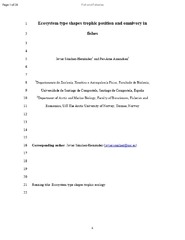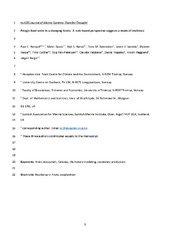Artikler, rapporter og annet (arktisk og marin biologi): Nye registreringer
Viser treff 1061-1080 av 1643
-
Ecosystem type shapes trophic position and omnivory in fishes
(Journal article; Tidsskriftartikkel; Peer reviewed, 2018-08-15)The identification of patterns in ecological characteristics of organisms is a central challenge in macroecology with a growing research interest. The goal of this study was to establish whether patterns in trophic ecology (trophic position and omnivory) of fishes can be extended to an ecosystem dimension (freshwater vs. marine environments), based on the premise that differences in environmental ... -
Remote sensing of zooplankton swarms
(Journal article; Tidsskriftartikkel; Peer reviewed, 2019-01-24)Zooplankton provide the key link between primary production and higher levels of the marine food web and they play an important role in mediating carbon sequestration in the ocean. All commercially harvested fish species depend on zooplankton populations. However, spatio-temporal distributions of zooplankton are notoriously difficult to quantify from ships. We know that zooplankton can form large ... -
Pelagic food-webs in a changing Arctic: a trait-based perspective suggests a mode of resilience
(Journal article; Tidsskriftartikkel; Peer reviewed, 2018-06-27)Arctic marine ecosystems support fisheries of significant and increasing economic and nutritional value. Commercial stocks are sustained by pelagic food webs with relatively few keystone taxa mediating energy transfer to higher trophic levels, and it remains largely unknown how these taxa will be affected by changing climate and the influx of boreal taxa. <i>Calanus</i> species store large quantities ... -
Seasonal ecology in ice-covered Arctic seas - Considerations for spill response decision making
(Journal article; Tidsskriftartikkel; Peer reviewed, 2018-09-05)Due to retreating sea ice and predictions of undiscovered oil and gas resources, increased activity in Arctic shelf sea areas associated with shipping and oil and gas exploration is expected. Such activities may accidentally lead to oil spills in partly ice-covered ocean areas, which raises issues related to oil spill response. Net Environmental Benefit Analysis (NEBA) is the process that the response ... -
New insights into the biology of Calanus spp. (Copepoda) males in the Arctic
(Journal article; Tidsskriftartikkel; Peer reviewed, 2018)Adult males of <i>Calanus</i> copepods in the Arctic are mainly observed between late autumn and late spring, and are seldom recorded during summer. Due to logistical constraints, there are still relatively few studies on zooplankton in high-latitude regions during the winter, and subsequently, little is known about <i>Calanus</i> males. Here, we present data on abundance, spatial distribution, ... -
Assessing local acceptance of protected area management using public participation GIS (PPGIS)
(Journal article; Tidsskriftartikkel; Peer reviewed, 2017-12-14)Protected area management can be highly contentious. Information about the acceptability of conservation actions can help environmental authorities design policies that are accepted locally, and identify potential areas of conflict between land users and conservation objectives. In this study, we implemented a spatially-explicit method for eliciting public preferences for land use and conservation ... -
Effects of acute exposure to dispersed oil and burned oil residue on long-term survival, growth, and reproductive development in polar cod (Boreogadus saida)
(Journal article; Tidsskriftartikkel; Peer reviewed, 2018-09-05)The present study investigates the potential long-term physiological effects on maturing polar cod (<i>Boreogadus saida</i>), an Arctic key species, after an acute exposure (48 h) to environmentally realistic concentrations of either mechanically dispersed oil (MDO), chemically dispersed oil (CDO) or burned oil residues (BO) (N = 58–60 per treatment). Following exposure, fish were monitored in a ... -
Effects of dietary crude oil exposure on molecular and physiological parameters related to lipid homeostasis in polar cod (Boreogadus saida)
(Journal article; Tidsskriftartikkel; Peer reviewed, 2018-03-17)Polar cod is an abundant Arctic key species, inhabiting an ecosystem that is subjected to rapid climate change and increased petroleum related activities. Few studies have investigated biological effects of crude oil on lipid metabolism in this species, despite lipids being a crucial compound for Arctic species to adapt to the high seasonality in food abundance in their habitat. This study examines ... -
Local land use associated with socio-economic development in six arctic regions
(Journal article; Tidsskriftartikkel; Peer reviewed, 2018-09-04)The socioeconomic causes of land use change are complex. They are highly context dependent, but most often studied through case studies. Here, we use a quasi-experimental paired block design to investigate whether better access to wage income leads to more visible land use around 28 settlements in six regions of the circumpolar Arctic. We mapped visible land use on high-resolution satellite images ... -
Small copepods matter: Population dynamics of Microsetella norvegica in a high-latitude coastal ecosystem
(Journal article; Tidsskriftartikkel; Peer reviewed, 2018-06-04)We investigated the population dynamics of a small and little-studied harpacticoid copepod, <i>Microsetella norvegica</i>, in a sub-Arctic Norwegian fjord (Balsfjord 69°N). We sampled with a 90 μm mesh WP-2 net and a 20 L Go-Flo bottle and found that the WP-2 under-sampled all juvenile stages. The abundance and biomass were high, peaking in June with 9349 × 10-<sup>3</sup> ind. m<sup>−2</sup> and ... -
Seasonal variation in the thermal responses to changing environmental temperature in the world's northernmost land bird
(Journal article; Tidsskriftartikkel; Peer reviewed, 2018-01-10)Arctic homeotherms counter challenges at high latitudes using a combination of seasonal adjustments in pelage/plumage, fat deposition and intricate thermoregulatory adaptations. However, there are still gaps in our understanding of their thermal responses to cold, particularly in Arctic birds. Here, we have studied the potential use of local heterothermy (i.e. tissue cooling that can contribute to ... -
Correlation between number of human cases of myiasis caused by the reindeer warble fly (Hypoderma tarandi) and weather conditions during summer in northern Scandinavia
(Journal article; Tidsskriftartikkel; Peer reviewed, 2018-12-19)The reindeer warble fly (<i>Hypoderma tarandi</i>) causes myiasis in reindeer and caribou (<i>Rangifer tarandus and subspecies</i>) and aberrant hosts such as humans. Of 22 human cases reported 1982–2016, 16 were children and 18 were residents in or visited northern parts of Norway or Sweden. Of a series of 39 new human cases in Norway 2011–2016 (reported 2017), 32 were children, 32 were resident ... -
Divergent responses of Atlantic cod to ocean acidification and food limitation
(Journal article; Tidsskriftartikkel; Peer reviewed, 2018-12-20)In order to understand the effect of global change on marine fishes, it is imperative to quantify the effects on fundamental parameters such as survival and growth. Larval survival and recruitment of the Atlantic cod (<i>Gadus morhua</i>) was found to be heavily impaired by end‐of‐century levels of ocean acidification. Here, we analysed larval growth among 35‐36 days old surviving larvae, along with ... -
High tolerance of a high-arctic willow and graminoid to simulated ice encasement
(Journal article; Tidsskriftartikkel; Peer reviewed, 2018-12-17)Climate change-induced snow thaw and subsequent accumulation of ice on the ground is a potential, major threat to snow-dominated ecosystems. While impacts of ground-ice on arctic wildlife are well explored, the impacts on tundra vegetation is far from understood. We therefore tested the vulnerability of two high-arctic plants, the prostrate shrub <i>Salix polaris</i> and the graminoid <i>Luzula ... -
The advective origin of an under-ice spring bloom in the Arctic Ocean using multiple observational platforms
(Journal article; Tidsskriftartikkel; Peer reviewed, 2018-02-13)Under-ice blooms of phytoplankton in the Chukchi Sea have been observed, with strong implications for our understanding of the production regimes in the Arctic Ocean. Using a combination of satellite remote sensing of phytoplankton biomass, in situ observations under sea ice from an autonomous underwater vehicle (AUV), and in vivo photophysiology, we examined the composition, magnitude and origin ... -
Statement on the use of untreated manure containing raw sewage. Opinion of the Panel on Biological Hazards of the Norwegian Scientific Committee for Food Safety
(Research report; Forskningsrapport, 2013-10-28)The Norwegian department of agriculture decided to re-evaluate the Regulation No. 951 of 4 July 2003 on fertilizers and soil improvers of organic origin. The Norwegian Food Safety Authority (NFSA) requested VKM for a statement on the use of manure from farms where grey water and human waste (sewage) is disposed of directly to the farm manure cellar. <br> Consideration was given to differences ... -
Contaminants in Atlantic walruses Part 2: Relationships with endocrine and immune systems
(Journal article; Tidsskriftartikkel; Peer reviewed, 2018-11-30)Marine mammals in the Barents Sea region have among the highest levels of contaminants recorded in the Arctic and the Atlantic walrus (<i>Odobenus rosmarus rosmarus</i>) is one of the most contaminated species within this region. We therefore investigated the relationships bewteen blubber concentrations of lipophilic persistent organic pollutants (POPs) and plasma concentrations of perfluoroalkyl ... -
Risk assessment on import of Australian redclaw crayfish to Norway. Opinion of the Panel on Animal Health and Welfare of the Norwegian Scientific Committee for Food Safety
(Research report; Forskningsrapport, 2016-11-30)<i>Main message</i>: It seems unlikely that the Australian red claw clayfish will establish reproductive populations under Norwegian climate conditions, but hitchhiker organisms and infectious agents could potentially follow the import, and unless managed, may pose risks to biodiversity and aquatic animal health. This is the conclusion in a risk assessment from the Norwegian Scientific Committee for ... -
On the resistance of epiphytic cyanobacteria of the Kola Bay to the effects of oil hydrocarbons in the aquatic ecosystem
(Journal article; Tidsskriftartikkel; Peer reviewed, 2018)The epiphytic communities of cyanobacteria of Fucus vesiculosus L. of the Kola Bay are able to bear the high amounts of the oil products in the environment. The results of studying the resistance of epiphytic cyanobacterial communities to oil pollution using both classical (cultural) and molecular-genetic methods of microbiological analysis have been presented. The objects of the study are the ... -
Miljørisikovurdering av genmodifisert maishybrid Bt11 x MIR604 x GA21 til mat, fôr, import og prosessering under EU-forordning 1829/2003/EF (EFSA/GMO/UK/2008/56). Uttalelse fra Faggruppe for genmodifiserte organismer i Vitenskapskomiteen for mattrygghet
(Research report; Forskningsrapport, 2013-03-19)I forbindelse med forberedelse til implementering av EU-forordning 1829/2003 i norsk rett, er Vitenskapskomiteen for mattrygghet (VKM) bedt av Direktoratet for naturforvalting (DN) om å utarbeide endelige miljørisikovurderinger av alle genmodifiserte organismer (GMOer) og avledete produkter som inneholder eller består av GMOer som er godkjent i EU under forordning 1829/2003 eller direktiv ...


 English
English norsk
norsk


















